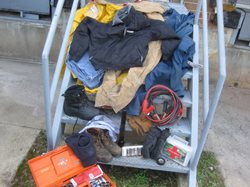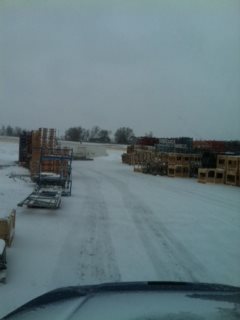 Over the weekend, I spent some time with a fellow “Team Run Smart” driver Jeff Clark. Together, we did some driver training on the Cascadia Evolution in Green Bay, Wisconsin.
Over the weekend, I spent some time with a fellow “Team Run Smart” driver Jeff Clark. Together, we did some driver training on the Cascadia Evolution in Green Bay, Wisconsin.
Jeff is leased on to his carrier PTI (Paper Transport Incorporated.) On Saturday, I enjoyed being part of a safety meeting program for PTI and their drivers. As an independent owner operator, I don’t get the chance to sit in on these types of meetings. The day included driver awards for safety, fuel mileage and performance. Each category included a bonus check to the winning drivers. Being in attendance for this meeting was a great refresher for me in regards to safety issues in general.
On Sunday morning in Wisconsin, I awoke to a fresh dusting of 1.5 inches of snow. After just attending the safety meeting, my thoughts turned to the issue of safely driving in the upcoming winter season. In the past, I’ve had my share of driving in the north and have experienced much snow and ice. Currently, my regular route is usually in a warm climate however each one of us should be prepared for the winter months ahead.
One of the first tips I learned early on as a driver was to be award of ice developing on the side mirrors and brackets. This can give you an early warning of ice on the road if your mirrors are icing.
My stepfather always told me to be aware of road spray. If the road looks wet and there is an absence of spray from your vehicle as well as others, it’s mostly that there is ice on the road.
It’s important in all-weather to maintain a safe following distance from the vehicle ahead of you. In slippery and icy weather conditions, it’s especially important to leave a greater margin of space for safety. Remember… bridges and overpasses will ice over before roads.
If you notice cars and trucks which have gone off the road due to weather conditions, it’s mostly likely that you should get off the highway yourself.
Some things I’ve learned over the years due to experience are to dry your brakes before parking for the evening. The easy way to do this is to lightly apply your brakes while pulling into the area in which you will park. This should create enough heat to dry out your brake pads so they aren’t frozen when you go to leave in the morning. Another tip… when you arrive at your parking spot, pull back and forth in the parking spot in order to cool your tires off so that the heat from them won’t melt the snow underneath your tires and turn to ice. I’ll usually do this practice about 4-5 times. I’ll fill out my paper work for the day and then do this again several times.

Make sure you have the proper winter supplies in your truck. Hat, gloves, warm coat, boots, flashlight, ain wear, coveralls, shovel, salt, kitty litter and finally a sledge hammer. The sledge hammer is a very handy tool should your brakes be frozen and need to be released. Prior to starting the process of getting a stuck brake to release, you’ll want to be sure to chock the wheels and only release only the tractor or trailer brakes at one time. This will avoid the truck or trailer from rolling over you once you have released the offending stuck brake shoe. By tapping on the brake drum, it will often release a set of frozen brake shoes.
Seasoned drivers will always tell you that safety comes first. Remember…no load is worth your or anyone’s life. Be safe…
 |
| The best feeling of all is arriving at your destination safely after driving through the snow. |